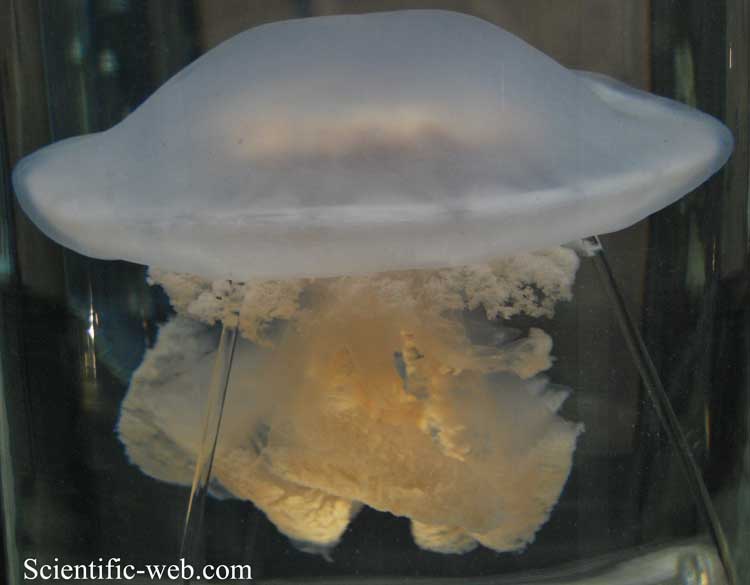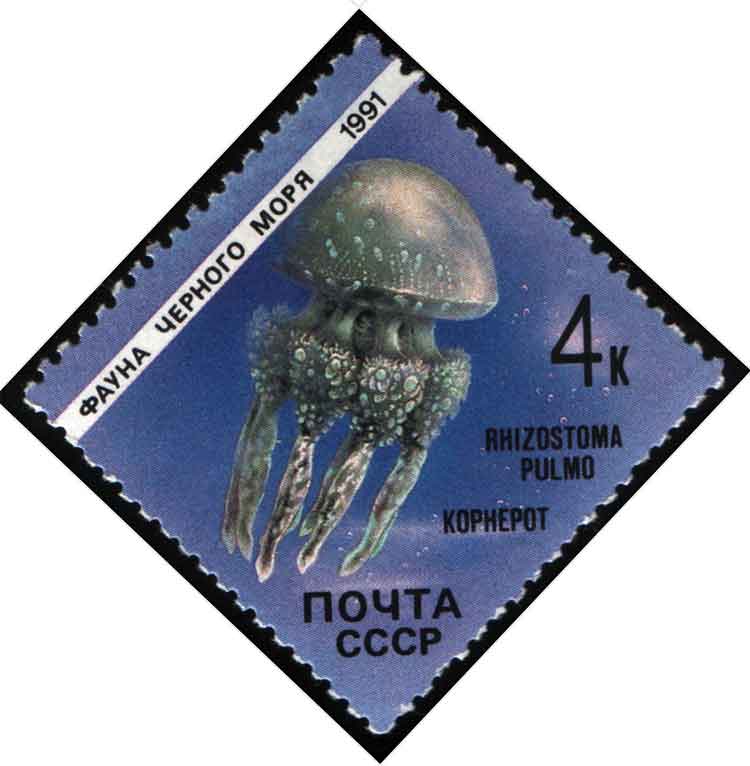
Rhizostoma pulmo, Photo: Michael Lahanas
Superregnum: Eukaryota
Cladus: Unikonta
Cladus: Opisthokonta
Cladus: Holozoa
Regnum: Animalia
Subregnum: Eumetazoa
Phylum: Cnidaria
Classis: Scyphozoa
Subclassis: Discomedusae
Ordo: Rhizostomeae
Familia: Rhizostomatidae
Genus: Rhizostoma
Species: Rhizostoma pulmo
Name
Rhizostoma pulmo (Macrì, 1778)
Synonyms
Medusa pulmo Macrì, 1778
Rhizostoma aldrovandi Péron & Lesueur, 1810

Rhizostoma pulmo, Biology Stamps
References
Macrì, S. 1778. Nuove osservazioni intorno la storia naturale del polmone marino degli antichi. Napoli. 36 pp. Google Books (alt. version with plate).
Vernacular names
čeština: Kořenoústka plicnatá
English: White Jellyfish
español: Medusa blanca
français: Méduse chou-fleur, Poumon de mer
italiano: Polmone di mare
Nederlands: Bloemkoolkwal
svenska: lungmanet
Rhizostoma pulmo, commonly known as the barrel jellyfish,[1] the dustbin-lid jellyfish or the frilly-mouthed jellyfish, is a scyphomedusa in the family Rhizostomatidae.[2] It is found in the northeast Atlantic, and in the Adriatic, Mediterranean Sea, Black Sea and Sea of Azov. It is also known from the southern Atlantic off the western South African coast and into False Bay.[3]
It is common in the Irish Sea. It typically is up to 40 cm (16 in) in diameter, but can exceptionally reach 150 cm (59 in) or larger,[4][5] making it the largest jellyfish in British and Irish waters (Cyanea capillata reaches an even larger size, but is generally smaller in Britain). On 13 July 2019, wildlife biologist Lizzie Daly dived off the coast of Cornwall in the United Kingdom, along with the underwater cinematographer Dan Abbott.[6] The two divers shared their encounter with a human-sized barrel jellyfish, Rhizostoma pulmo. The species could typically grow up to one meter (3.2 feet) and weigh up to 25 kilograms (55 lbs). However, they are not larger than the lion's mane jellyfish.[7]
Rhizostoma pulmo is moderately venomous but not as deadly as other species. Effects include a burning sensation on the skin, dermatitis, and ulcers which confirms it is toxic to humans. However, it does not pose a serious threat to humans.[8]
It is a favourite food of the leatherback turtle.[9]
Rhizostoma pulmo washed ashore at Bournemouth in southern England
Orifice of a barrel jellyfish
In Asia, they are a source of bioactive compounds used in traditional food and medicine.[10] One study indicates that washing in aqueous solutions and the separation of high molecular weight proteins from the extract, e.g., by membrane filtration, could be a way to remove possible toxic compounds from jellyfish extracts and to concentrate potentially bioactive soluble compounds. The potentially active soluble components may have uses as nutraceutical and cosmeceutical ingredients.[11]
References
Aquarium of Genoa – species description: Rhizostoma pulmo. Retrieved 31 May 2013.
"Dustbin-lid jellyfish - Rhizostoma pulmo". MarLIN. Retrieved 16 September 2011.
Branch, G.M., Branch, M.L, Griffiths, C.L. and Beckley, L.E. 2010. Two Oceans: a guide to the marine life of southern Africa ISBN 978-1-77007-772-0
"Rhizostoma pulmo, barrel jellyfish".
"Massive, Human-Size Jellyfish Stuns Divers off the Coast of England". Live Science.
"Divers 'humbled' by giant jellyfish encounter". BBC News. July 17, 2019.
"Humans Who Swam Along a Human-Sized Jellyfish". Mirror Herald. Archived from the original on 20 July 2019. Retrieved 17 July 2019.
Mariottini, Gian Luigi; Pane, Luigi (4 April 2010). "Mediterranean Jellyfish Venoms: A Review on Scyphomedusae". Marine Drugs. 8 (4): 1122–1152. doi:10.3390/md8041122. PMC 2866479. PMID 20479971.
"COAST : Community of Arran Seabed Trust - Barrel Jellyfish". www.arrancoast.com. Archived from the original on 29 May 2018. Retrieved 29 May 2018.
Omori, Makoto; Nakano, Eiji (1 May 2001). "Jellyfish fisheries in southeast Asia". Hydrobiologia. 451 (1): 19–26. doi:10.1023/A:1011879821323. S2CID 6518460.
De Domenico, Stefania; De Rinaldis, Gianluca; Paulmery, Mélanie; Piraino, Stefano; Leone, Antonella (2019). "Barrel Jellyfish (Rhizostoma pulmo) as Source of Antioxidant Peptides". Marine Drugs. 17 (2): 134. doi:10.3390/md17020134. PMC 6410228. PMID 30813405.
Retrieved from "http://en.wikipedia.org/"
All text is available under the terms of the GNU Free Documentation License

